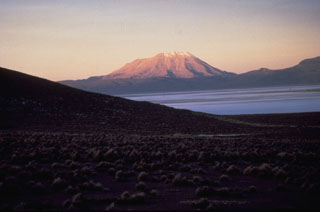Report on Ubinas (Peru) — 14 May-20 May 2014
Smithsonian Institution / US Geological Survey
Weekly Volcanic Activity Report, 14 May-20 May 2014
Managing Editor: Sally Sennert.
Please cite this report as:
Global Volcanism Program, 2014. Report on Ubinas (Peru) (Sennert, S, ed.). Weekly Volcanic Activity Report, 14 May-20 May 2014. Smithsonian Institution and US Geological Survey.
Ubinas
Peru
16.345°S, 70.8972°W; summit elev. 5608 m
All times are local (unless otherwise noted)
IGP's Observatorio Volcanologico de Arequipa (IGP-OVA) and Observatorio Vulcanológico del INGEMMET (OVI) reported that during 14-16 May emissions at Ubinas continued. On 14 May emissions with minor amounts of ash rose 0.6-1.8 km above the crater. An explosion at 1902 on 14 May ejected fragments around the crater and caused thick ashfall in Chojata and Escacha. Water vapor and ash plumes rose 0.7-3.5 km on 15 May, and gas, steam, and ash plumes rose 500-800 m on 16 May. A moderate explosion at 1915 on 18 May was followed by nine hours of continuous emissions. Later that day gas-and-ash plumes rose 0.4-1.1 km. During 14-16 and 18 May ash fell in various towns downwind of the plumes, including Querapi (4 km S), Ubinas (6.5 km SSE), Escacha, Lloque, Chojata, and Tonohaya.
A news article from 15 May noted that the mayor of the district of San Juan de Tarucani in Arequipa continued the effort to relocate families.
Geological Summary. The truncated appearance of Ubinas, Perú's most active volcano, is a result of a 1.4-km-wide crater at the summit. It is the northernmost of three young volcanoes located along a regional structural lineament about 50 km behind the main volcanic front. The growth and destruction of Ubinas I was followed by construction of Ubinas II beginning in the mid-Pleistocene. The upper slopes of the andesitic-to-rhyolitic Ubinas II stratovolcano are composed primarily of andesitic and trachyandesitic lava flows and steepen to nearly 45°. The steep-walled, 150-m-deep summit crater contains an ash cone with a 500-m-wide funnel-shaped vent that is 200 m deep. Debris-avalanche deposits from the collapse of the SE flank about 3,700 years ago extend 10 km from the volcano. Widespread Plinian pumice-fall deposits include one from about 1,000 years ago. Holocene lava flows are visible on the flanks, but activity documented since the 16th century has consisted of intermittent minor-to-moderate explosive eruptions.
Sources: Instituto Geofísico del Perú (IGP), Instituto Geológico Minero y Metalúrgico (INGEMMET)

